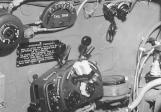17
As a high powered twin engine aircraft, the Mosquito was particularly tricky during takeoff. Add in the factors of night combat flying, bad weather, and a full load of bombs and fuel, and you have the recipe for disaster for a novice pilot. Once airborne and past the single engine safety speed of 155 mph., the cockpit of a Mosquito was one of the safest places to be in WW II.Mosquito researcher Norm Malayney has documented that 14 of the 40 USAAF F-8 Mosquitos were written off in accidents during takeoff or landing during 1944, especially if an engine failure was involved. Three incidents involved ground looping on landing, three by brake failure, and another by undercarriage failure. Engine failure on takeoff was the cause of half of the accidents.
Mosquito veteran George Stewart thinks the USAAF could have benefitted from an Operational Training Unit (OTU). He said he never had any problems handling the Mosquito on takeoff because his instructor taught him to get the power up, get the tail up, get airborne, and get the undercarriage up, all as quickly as possible. That way, if you were going to blow an engine it would happen sooner rather than later, giving you time to abort safely if necessary, and you would be out of the danger zone in seconds.


